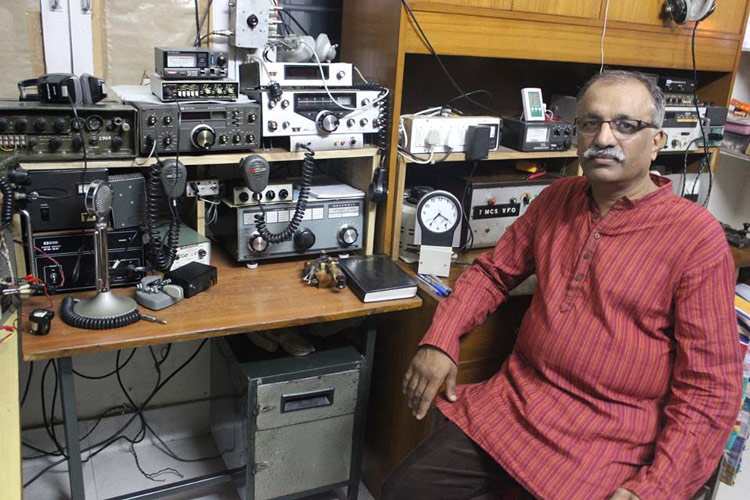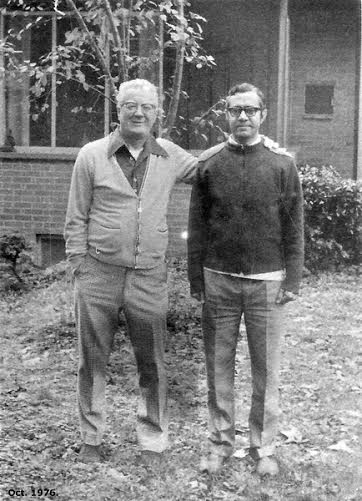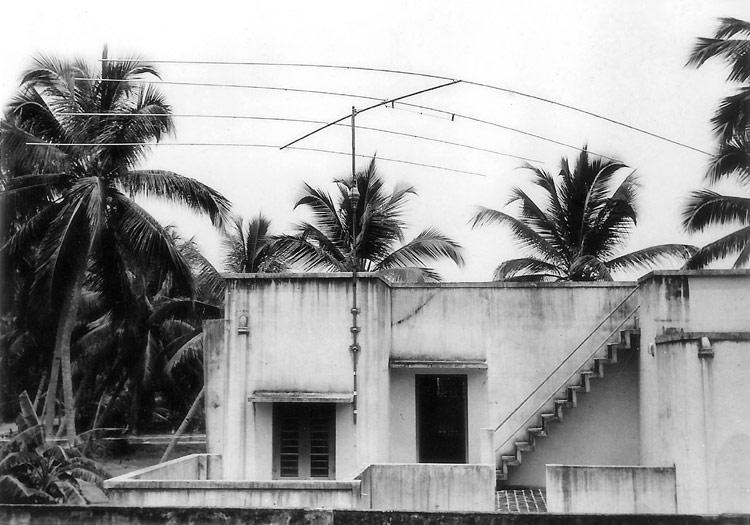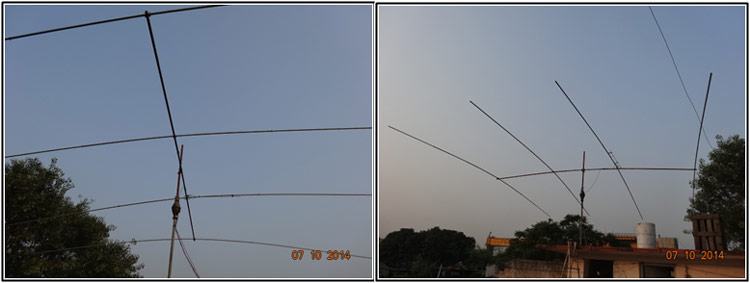
The author, Venu VU2MV in his Hamshack
W3AU, VU2MV, VU2JN AND THE GOTHAM BEAM!

The author, Venu VU2MV in his Hamshack
THE STORY OF RESURRECTION OF A GOTHAM BEAM
Gotham beams, manufactured by Gotham, Miami Beach, Florida, U.S.A., were cost-effective monobander antennas of 1960 vintage. In those days, a four-element 20-metre full-sized Gotham yagi with 20-feet GI boom (in two sections) and hard aluminium elements (each element in 3 sections) cost around 40 dollars. Such a beam configuration had a specified front-to-back ratio of 33 dB and a forward gain of 9 dB -- excellent specifications, considering the low cost of the beam.
An avid DX-er of the nineteen sixties and seventies, the late Ed Bissell (W3MSK/VU2MSK/W3AU) was working as an electrical engineer with NASA in USA. He visited India in 1967 and 1970 to assist in the initial setting up of the Indian Space Research Programme. He was stationed at Thiruvanthapuram and was the first US ham to get a reciprocal Indian licence. He was a keen Dxer / Contester and had formed a group of amateurs known as the 'MSK gang', who were members of the Potomac Valley Amateur Radio Club (PVARC) and excelled in ARRL and CQ worldwide contests during the nineteen fiftees to nineteen seventees.

Ed Bissell W3AU, Prof. Jayaraman VU2JN
During his stay in Thiruvananthapuram, Ed Bissell built lasting relationships with local hams, especially Prof Jayaraman (VU2JN) and the late Krishnan Kutty (VU2PKK). In those days, Prof Jayaraman was a regular contributor to magazines like QST, CQ, 73 and The Indian Radio Amateur. Some of his classic articles were: A Transistor Transmitter from India (QST, Nov.1967), The Transistor Giant (QST, Oct.1969), A Deluxe 40673 Converter (CQ, Feb. 1970), Deluxe Receiver Gain Control (73, Sep.1970) and The Gigohmer - a Gigaohm Adapter for your Multimeter (CQ, Apr.1973).
Prof Jayaraman sought Ed's help for identifying a suitable beam for his shack. Ed procured a Gotham 20-metre 4-element monobander beam along with a Ham-M Rotator, CDR Controller, required hardware etc, and brought them to Thiruvanthapuram in 1970. Ed also helped Prof Jayaraman in assembling and raising the Gotham 20M beam. The attached photo taken in 1970 shows a view of the full-sized monobander beam.

A REAL Gotham antenna in the AIR at VU2JN in 1970!
Prof Jayaraman had a hectic time working DX with his 3x1625 homebrew TX and the Gotham beam. The performance of the beam was excellent, and some of the US hams reported that VU2JN's CW signal was the strongest 20-metre signal heard from Asia in USA. Prof Jayaraman reckons this as a great tribute to the humble Gotham beam! But the beam and its glory were short-lived as Prof Jayaraman had to dismantle it prior to his moving to IIT Madras in 1971, in order to pursue his doctoral research work. The disassembled beam was stored in its original carton, and did not see the light of the day for the next 43 years!
The author was a student at College of Engineering, Thiruvananthapuram from 1982 to 1987, where Prof Jayaraman was Dean and later Principal. The author had acquired his original call sign VU2MVX even before joining the College of Engineering, Thiruvananthapuram.
Under Prof's guidance and the active participation of the author and his friends, an Amateur Radio Club station was formed in the college with the call VU2TEC. The club was quite active from 1984 to 1989.
During the author's weekend visits to Prof's shack, there used to be mention of the glorious days of the Gotham beam. After completing his studies, the author joined the Indian Air Force, and not much was heard about the Gotham beam. During one of the author's later visits to Prof's shack, Prof mentioned that he intended to dispose of the beam and its accessories. The author jumped at the offer and the gracious guru gave the beam, rotator, control box and accessories to his former student, accepting a token payment.
All the items were brought to New Delhi in 2012, where the author is stationed. As a preliminary step, all the hardware were cadmium-plated to ward off rusting. On the advice of OM Paranjpe (VU2AU) and OM Raja (VU2KSJ), the boom length was increased from 20 feet to 24 feet by bolting a GI pipe of 1" dia at the centre of the original boom. The elements were made of aluminium tubes of dia. varying from 1" downwards. Each element consisted of 3 telescoping 12' sections of Al pipe. One section of the second director element had got damaged. It was made good by adding Al tubes at either end. Finally the elements were assembled after calculating the length of reflector, driven element and directors for a frequency of 14.100 MHz (to suit both cw and ssb portion of the band). The length of reflector, driven element and directors worked out to be 35’6” ,33’7” ,31’9” and 31’7” respectively. The elements were mated to the boom using U-clamps and crocodile holders. Spring washers and locknut compound were used to ensure the required tightness and rigidity. A uniform spacing of 8’ was maintained between the elements. (the spacing needs to be optimised by trial)
A Gamma match was added to the driven element by suspending a 1cm dia. Al tubing of 4' length suspended 4” below the driven element, using bakelite spacers. A length of the centre conductor and polythene insulation of RG8-U coaxial cable, sliding inside the Al tubing, formed the Gamma match. A slider connecting the tube to the element determines the feed point. The objective was to and cancel the reactance by adjusting the sliding conductor inside the Al tubing and the feed-point for a resistive component of 50 ohms.
The matching was optimized using a MFJ-259 Antenna Analyser connected at the antenna end. As a temporary arrangement the beam was oriented to 'Short path' facing the North pole, and was bolted to a wooden box of 4 feet height placed on the roof of the staircase room at a height 30 feet above the ground. This arrangement was resorted to as the author felt that the braking arrangement used in the rotor in combination with the controller needed modification. As can be seen from the photos, the Ham-M Controller has a lever at the bottom, the movement of which to left or right releases the solenoid brake and energises the rotator simultaneously. Bringing the lever back to the centre engages the brake on the moving beam even before it comes to a halt, thus straining the motor and brake. Also the braking produces a loud sound. The subsequent series of controllers overcame this inadequacy by having separate controls for rotation and braking, ensuring possible manual delay in application of brake. With the help OM Salim, VU2LID/ N8LI, a Ham series 2 controller was purchased from e-Bay and the same was successfully integrated with Ham M rotator. This ensured smooth and delayed braking. The author plans to incorporate an adjustable automatic delay between switching off of the motor and application of brake, by adopting the method suggested in an article which appeared in Sep.2013 issue of QST (pages 30-31).( picture of HAM M CONTROLLER AND HAM SERIES 2 CONTROLLER)
On 7th Oct 2014, with help from OM Rajesh VU2ESH, the rotator was installed on the mast and the boom with the elements were integrated to it at a height 2 feet above the rotor. The functional checks were carried out and were satisfactory. The beam is now performing well with good reports from all around. Strange but true, even when the beam was in its temporary position on the wooden box, the author received comments like 'the strongest CW station from VU in USA'. This brought nostalgic memories of the beam's performance in 1970 at Prof's shack.

2 Views of the Gotham Beam at VU2MV
The author dedicates the resurrected beam to the memory of the late Ed Bissell, W3AU, who passed away in 2003. The project would not have been a reality without the guidance from Prof Jayaraman. The author remembers with gratitude the help received from VU2LID, VU2AU, VU2KSJ, VU2PRV, VU2KNN, VU2ESH, VU2OB ,VU2PTR and many other ham friends.
Article and photos courtesy of VU2MV
This site is copyright by Tim Duffy K3LR.
All Rights Reserved. All art, photos, and html is property of Tim
Duffy.